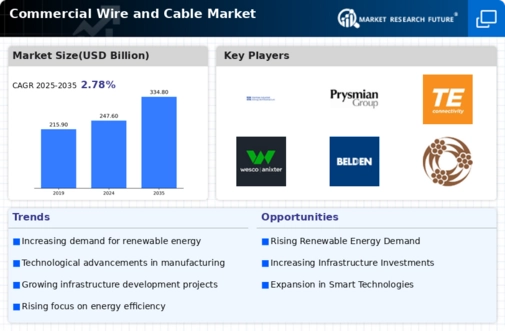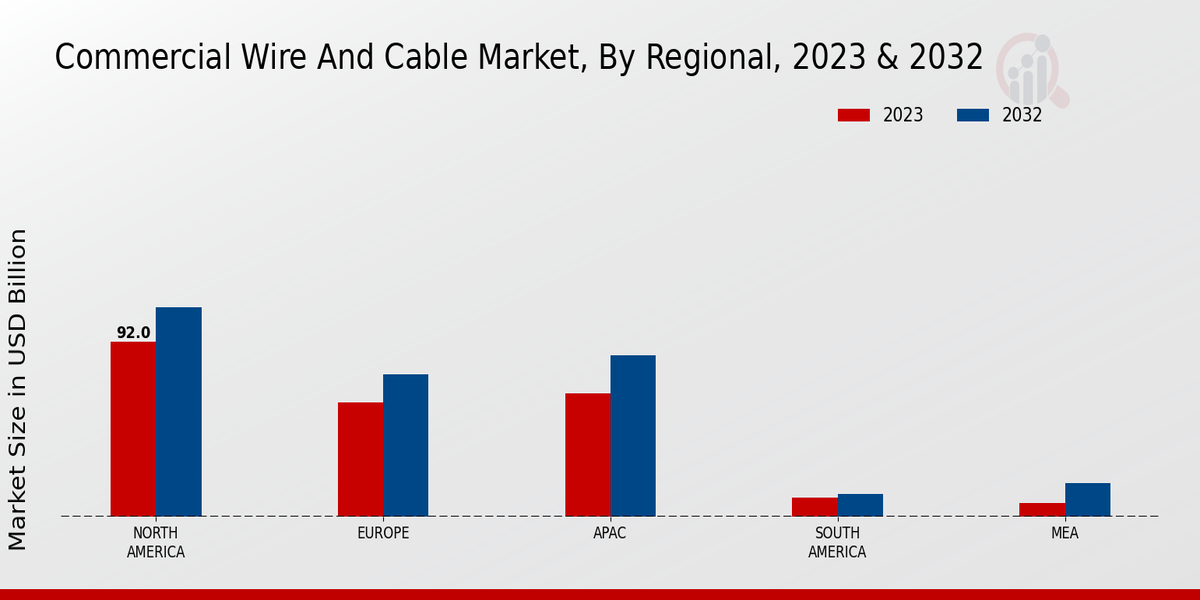Increased Construction Activities
The resurgence of construction activities across various sectors is significantly influencing the Commercial Wire and Cable Market. As urbanization accelerates, there is a heightened need for electrical wiring in residential, commercial, and industrial buildings. The construction sector is projected to grow at a steady pace, with investments in infrastructure development reaching unprecedented levels. This growth is particularly evident in emerging markets, where urban infrastructure projects are on the rise. The demand for durable and efficient wiring solutions is paramount in these projects, as they ensure safety and reliability. Consequently, the Commercial Wire and Cable Market stands to gain from the increasing construction activities, as more projects require advanced cabling systems to meet modern electrical standards.
Rising Demand for Renewable Energy
The increasing emphasis on renewable energy sources is driving the Commercial Wire and Cable Market. As countries strive to meet energy transition goals, the demand for wires and cables that support solar, wind, and other renewable energy projects is surging. For instance, the International Energy Agency indicates that investments in renewable energy infrastructure are expected to reach trillions of dollars in the coming years. This trend necessitates specialized cables that can withstand various environmental conditions, thereby enhancing the market's growth. Furthermore, the shift towards electric vehicles is also contributing to the demand for high-quality wiring solutions, as these vehicles require advanced cabling systems for efficient energy transfer. Consequently, the Commercial Wire and Cable Market is poised to benefit significantly from these developments.
Regulatory Standards and Compliance
The establishment of stringent regulatory standards and compliance requirements is a crucial driver for the Commercial Wire and Cable Market. Governments and regulatory bodies are increasingly mandating safety and quality standards for electrical installations, which necessitates the use of high-quality wiring solutions. Compliance with these regulations not only ensures safety but also enhances the reliability of electrical systems. As a result, manufacturers are compelled to innovate and produce cables that meet these stringent standards. This trend is particularly evident in sectors such as construction and telecommunications, where adherence to safety regulations is paramount. Consequently, the Commercial Wire and Cable Market is likely to experience growth as companies invest in compliant and high-quality cabling solutions to meet regulatory demands.
Expansion of Telecommunication Networks
The rapid expansion of telecommunication networks is a pivotal driver for the Commercial Wire and Cable Market. With the increasing reliance on high-speed internet and mobile connectivity, there is a pressing need for robust cabling solutions. The demand for fiber optic cables, in particular, is witnessing substantial growth, as they offer superior data transmission capabilities. According to industry reports, the fiber optic cable market is projected to grow at a compound annual growth rate of over 10% in the next few years. This expansion is further fueled by the rollout of 5G technology, which requires extensive cabling infrastructure to support its high-speed data transfer. As a result, the Commercial Wire and Cable Market is likely to experience a significant uptick in demand for innovative cabling solutions.
Technological Innovations in Cable Manufacturing
Technological innovations in cable manufacturing are reshaping the Commercial Wire and Cable Market. Advances in materials science and production techniques are leading to the development of cables that are not only more efficient but also environmentally friendly. For instance, the introduction of low-smoke, zero-halogen cables is gaining traction due to their safety benefits in case of fire. Additionally, the integration of smart technologies into cabling systems is enhancing their functionality, allowing for better monitoring and management of electrical systems. These innovations are expected to drive market growth, as consumers increasingly seek high-performance and sustainable wiring solutions. The Commercial Wire and Cable Market is thus likely to benefit from these technological advancements, which cater to the evolving needs of various sectors.



















Leave a Comment